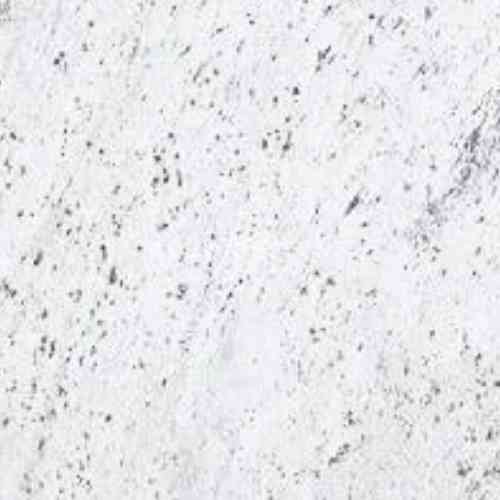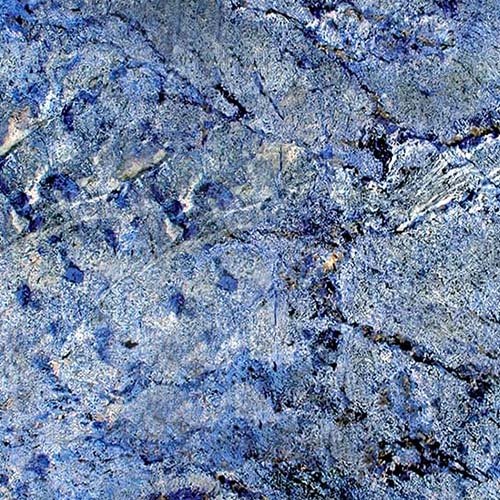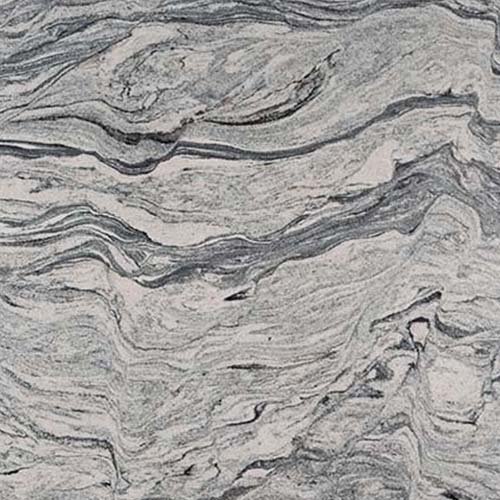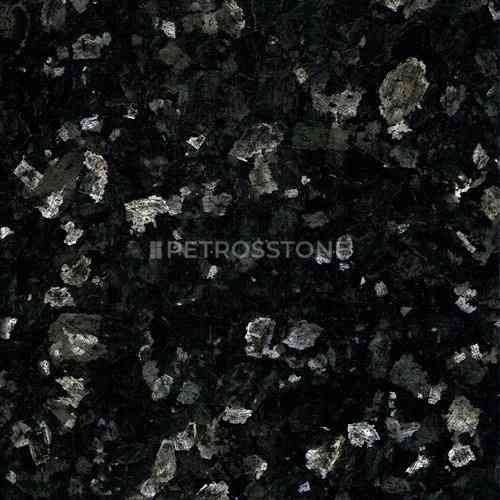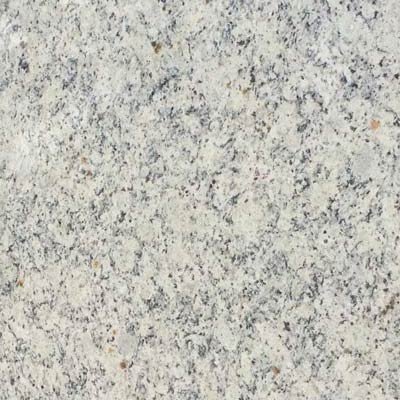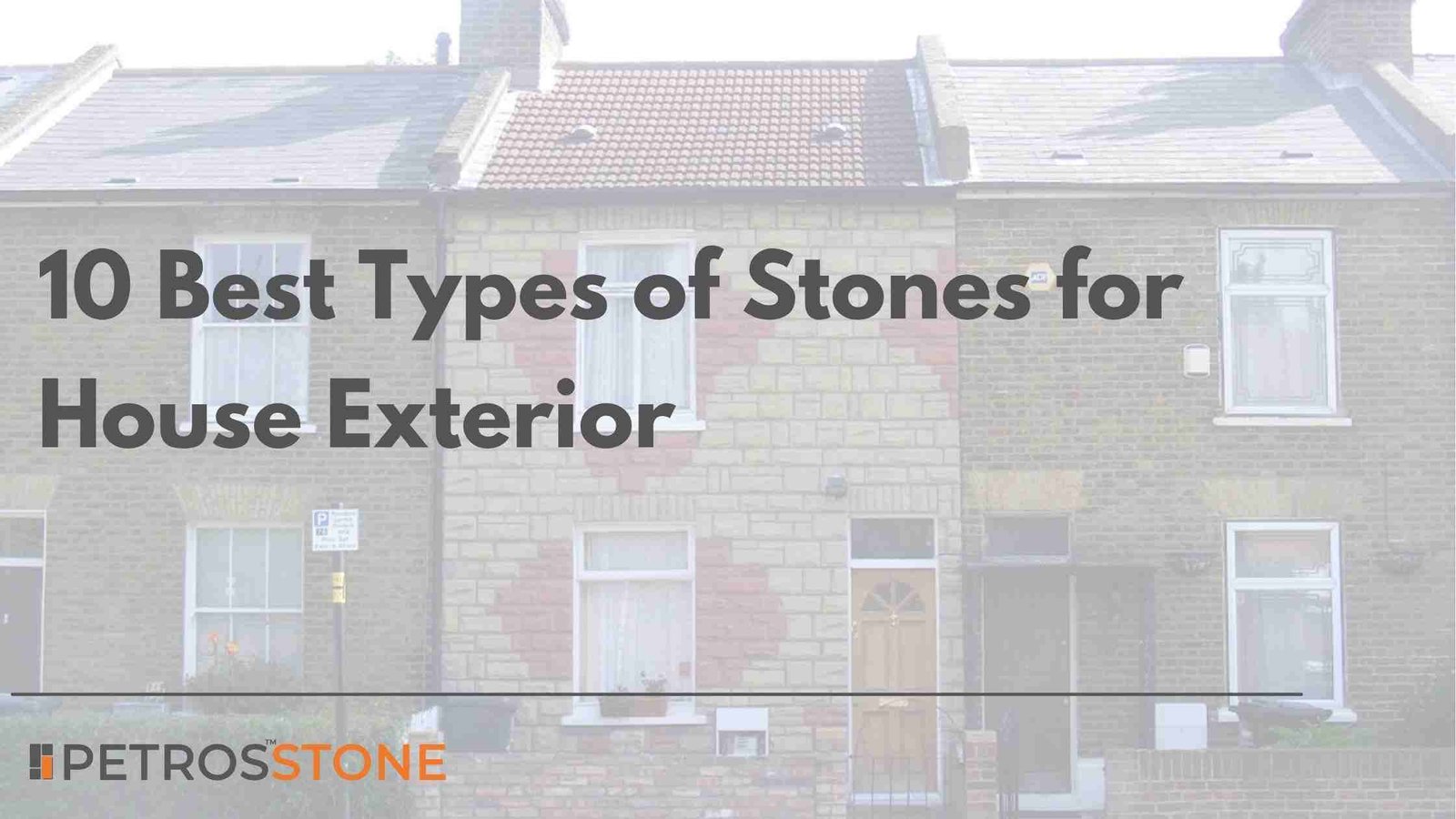
Selecting natural stone walls for your house exterior is an informed decision that enhances your home’s beauty, durability, and longevity. However, with a wide variety of options in the Indian market, it is a challenging task to find the exact match that combines visual appeal and long-term value.
Among the many materials available, natural stone wall cladding remains a timeless and high-impact choice, offering a blend of aesthetic appeal, structural integrity, and low long-term maintenance.
In this article, we will introduce you to the 10 best types of stone cladding for house exteriors. Before diving in, let us first run you through the key design and functional factors that should shape your decision when investing in natural stone for exterior applications.
- Key Factors in Choosing House Exterior Stones
- 10 Best Stone Tiles For House Exterior
- 1. Natural Mint Quartzite Cladding Stone
- 2. Black Marble Cladding Stone
- 3. Rustic Castle Finish Stone Cladding
- 4. Kandla Grey Sandstone Wall Cladding
- 5. Desert Multi-Stone Cladding
- 6. Indian Autumn Slate Cladding
- 7. Beige Limestone Split-Face Cladding
- 8. Forest Brown Ledge Quartzite Ledge Panel
- 9. Tumbled Mint Sandstone Tiles
- 10. Golden Yellow Sandstone Strips
- FAQs
- Summary
- Key Takeaways
Key Factors in Choosing House Exterior Stones
- Climate and Durability: Volatile climatic conditions in India demand stones with low porosity, or they run the risk of absorbing moisture.
- Maintenance: Each stone demands a different level of attention. High-porosity stones like marble show dust and stains easily and require regular cleaning and sealing.
- Design Narrative: Stone tiles should align with your house’s architectural integrity.
- Budget v/s Lasting Value: A high-quality stone tile might have high initial costs, but the choice can significantly reduce maintenance and replacement costs over time.
- Installation: For exceptional durability and a more refined finish, interlocking cladding with skilled labor, compared to traditional wet-fixed methods, makes a huge difference.
10 Best Stone Tiles For House Exterior
Here are our top 10 recommendations, each selected based on the key factors covered above.
1. Natural Mint Quartzite Cladding Stone
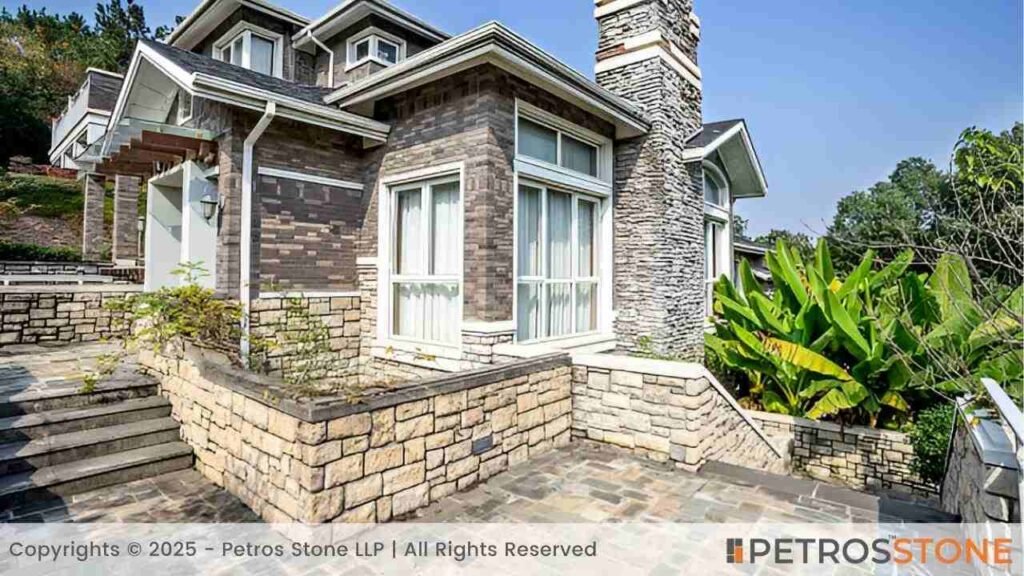
Renowned for strength, durability and low maintenance, it offers an ethereal green hue and timeless sophistication for your home.
Average Stone Cost: $1.45 – $2.15 /sq ft
Pros
- Ancient cultures valued quartz for its rich beauty and unique patterns. Mint quartzite brings that legacy to the table.
- Quartzite is exceptionally durable as its low porosity and dense structure make it resilient to moisture and thermal expansion – ideal for India’s varied climatic conditions.
- With proper installation, quartzite requires very low maintenance. Also, it is highly resistant to dust and stains.
- Buyers see mint quartzite as an enduring and eco-conscious option. It pairs beautifully with wood, glass, metal, timber, or even exposed brick. Natural mint quartzite also gives great thermal insulation and regulates interior temperatures.
Cons
- Quartzite is dense, but without proper sealing, it can absorb stains, leading to surface discoloration and loss of luster. The chances of etching while exposed to acidic substances are also high.
- Improper installation can cause cracking due to quartzite’s weight and hardness. Weight distribution is critical, and proper care is needed for transport and installation in structurally challenging landscapes.
- The earthly palettes of mint quartzites have unique patterns, but it also means fewer colour variations.
Top Design Ideas
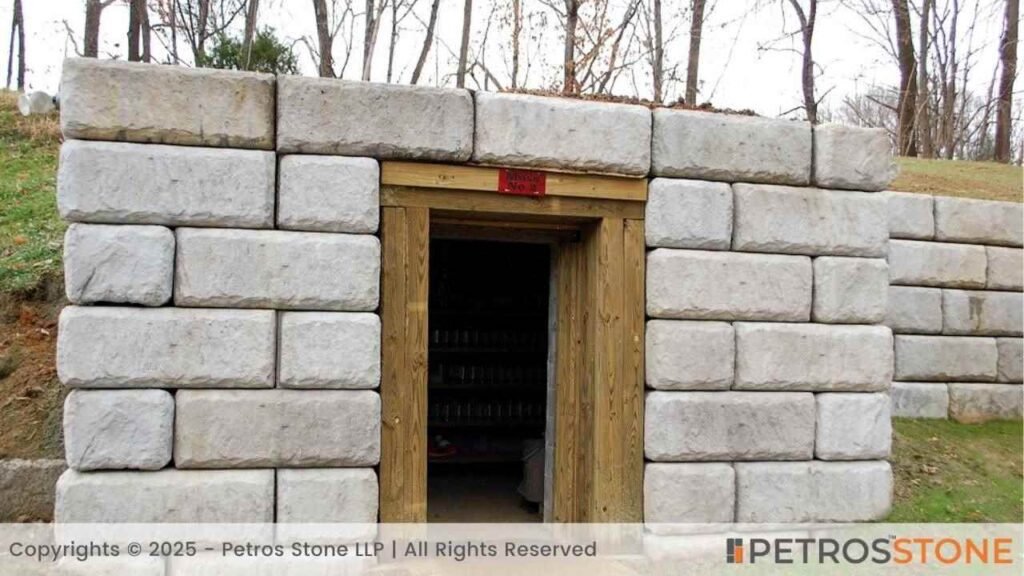
- Tumbled Mint Stone for Villa Exteriors: Earthly textures and soft edges for classic villas
- Random Ashlar Pattern for Exteriors: Uneven mint blocks for rustic charm
- Linear Strips for Accent Walls: Sleek design delivering a cool, minimalistic vibe
- Rustic Bush-Hammered Finish for Porch Cladding: For cool shelters
Takeaway
Because of natural mint quartzite’s durability, low-maintenance, elegance, eco-value, and compatibility, it is a standout choice among natural stone wall options.
2. Black Marble Cladding Stone
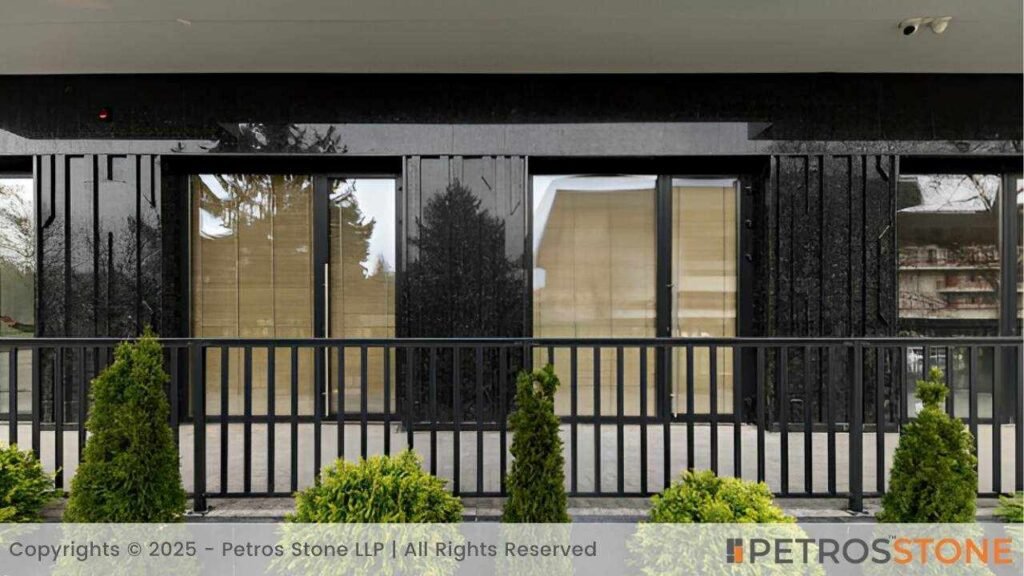
Black marble cladding stone adds serious depth to exterior stone wall designs. Its silvery black surface lends a bold luxury that fits both contemporary and traditional homes.
Average Stone Cost: $2.15 – $3.60 /sq ft
Pros:
- This stone wall cladding shines in a dark, sophisticated look, but is cool even in the scorching heat of the sun.
- While not the hardest, black marble cladding is long-lasting and resists wear well. Due to its smooth finish, it resists dust and is easy to wipe clean.
- It pairs seamlessly with metal, glass, concrete, or even wood. Indoor temperature is naturally regulated, as a steady coolness is maintained throughout all seasons.
Cons:
- Unlike granite and quartzite, black marble stone cladding can absorb pollutants, rainwater or oil. Without proper sealing or regular cleaning, the chances of etching or dullness over time are high.
- Without doubt, marble is heavy. So it demands a structurally adept building to support its weight of cladding.
- As marble is soft, the chances of chipping or cracking during installation is high. It requires sensitive handling and skilled labor.
Top Design Ideas:
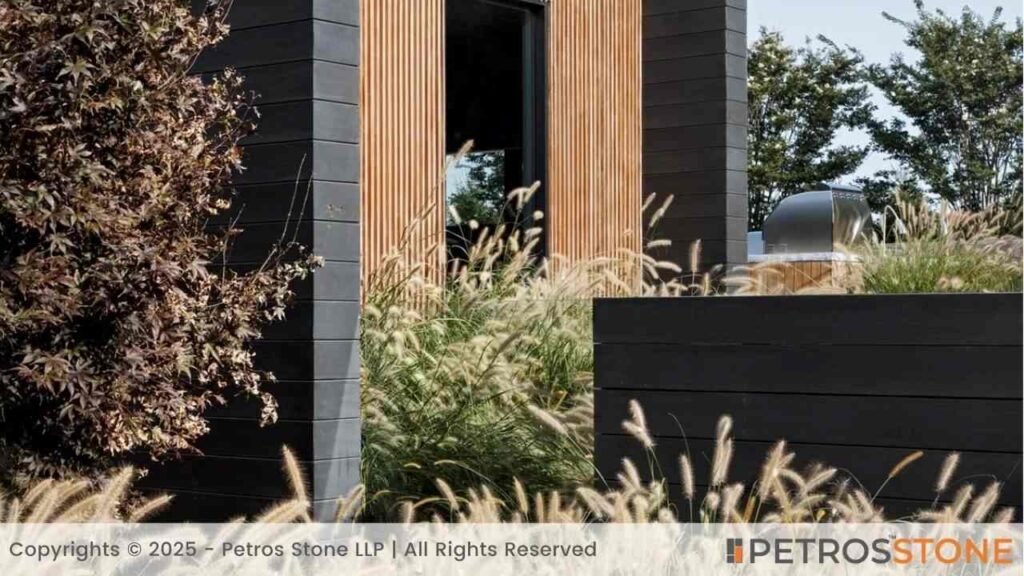
- Polished Black Marble Facade: Mirror-like contrast for sleek fronts
- Black Marble for Boundary Walls: A matt-finish edge for your walls
- Vertical Rectangular Panel Cladding: Tall panels for great visual scale
- Marble Veins for Entryways: Natural streaks for stunning entryways
Takeaway:
Black marble cladding stones bring home a modern edge. With easy upkeep, they stand out as a proud and premium choice for exterior design.
3. Rustic Castle Finish Stone Cladding
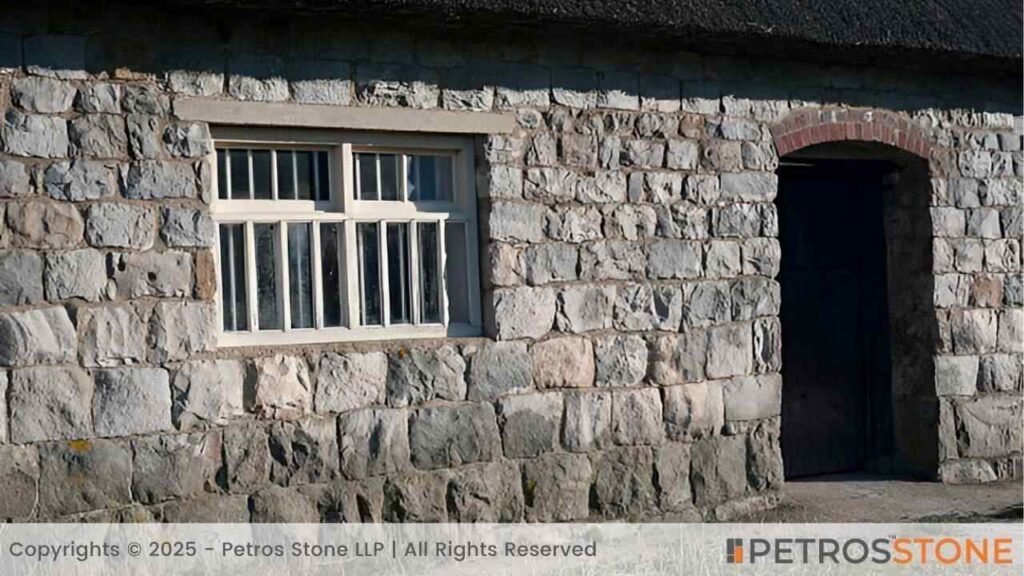
The rustic castle finish is for those who lean towards a rugged flair for their house.
Average Stone Cost: $1.80 – $3.00 /sq ft
Pros:
- Its trademark imperfections and hand-cut feel bring the rawness of age-old structures to house exteriors. This stone is naturally durable and resistant to wear and chipping. With proper installation and maintenance, it can last for a long time. What’s more, the vintage value of the property only tends to appreciate over time.
- This natural stone wall with a tough build can face all weather conditions. Only basic washing and occasional sealing are enough to keep it clean. Also, rooms stay cool, naturally.
Cons:
- It costs more than a factory-finished alternative. The natural thickness adds significant weight too, demanding proper anchoring. Skilled labor is a must, and improper installation might lead to cracks or failure over time.
- Its coarse texture can trap more dirt, demanding regular cleaning and proper sealing.
Top Design Ideas
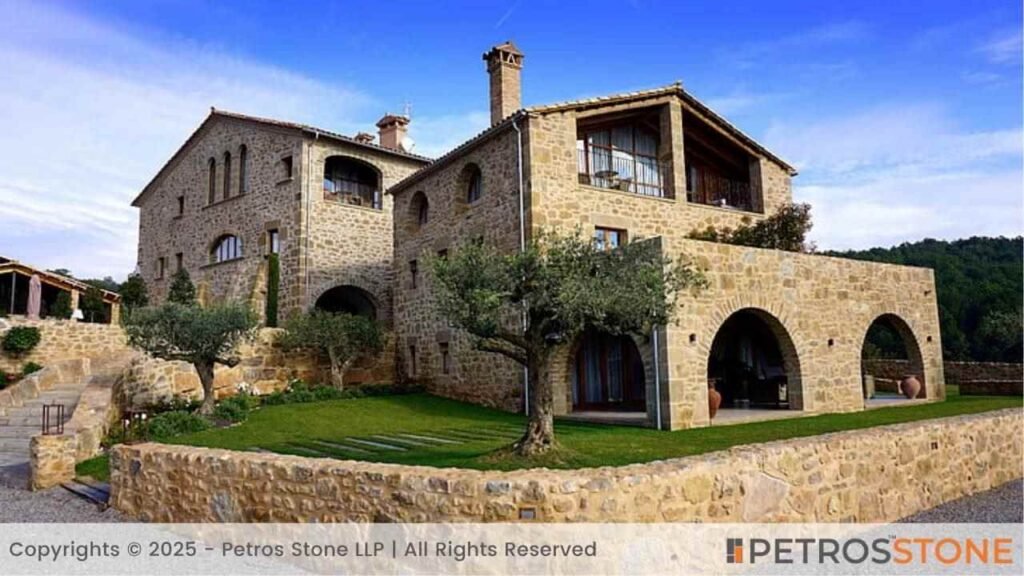
- Rustic Farmhouse Walls: Uneven textures for a lived-in charm
- Castle-Finish Courtyard Accent: For open areas that are warm and weathered
- Verandah Half-Walls: Vintage-mood low walls and shaded porches
- Outdoor Seating Backdrops: Calm background for garden lounges
Takeaway:
This rustic stone cladding is tough to install and has a higher upfront cost, but its visual impact and value in the long run make it a grounded choice for heritage-inspired designs.
4. Kandla Grey Sandstone Wall Cladding
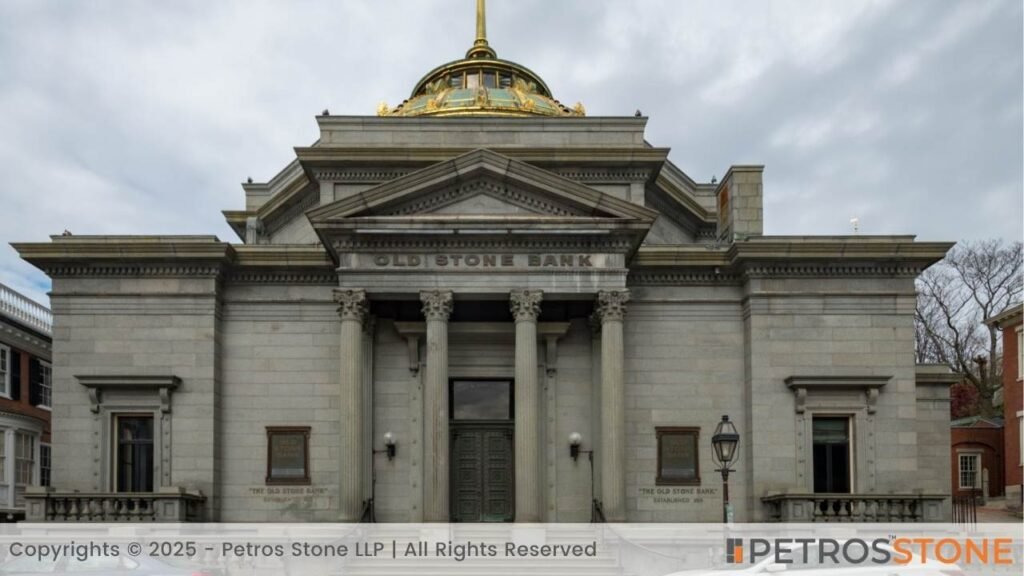
With its rustic look, the kandla grey sandstone has a unique and cool persona suitable for both traditional and minimalistic homes.
Average Stone Cost: $0.80 – $1.35 /sq ft
Pros:
- The clean and contemporary look of kandla grey sandstone blends well with most other materials. It is also ideal for long-term use owing to its hardness and wear-resistance.
- The grey sandstone is resilient to all weather conditions and needs low maintenance. Sourcing and replacements are smooth due to easy availability.
Cons:
- The greys in the stone may lighten under prolonged exposure to sunshine. Without sealing, it is prone to absorb moisture and stains. Also, poor installation or careless transport can result in chipping.
Top Design Ideas

- Contemporary Facades: Calming grey slabs for exteriors
- Sandstone Pillars: Columns with timeless finish
- Accent Walls for Courtyards: A subtle touch to open places
- Patio or Terrace Feature Walls: Seamless design for open ambience
Takeaways:
With their naturally attractive design and wide availability, they are a highly dependable option for exterior stone wall cladding.
5. Desert Multi-Stone Cladding
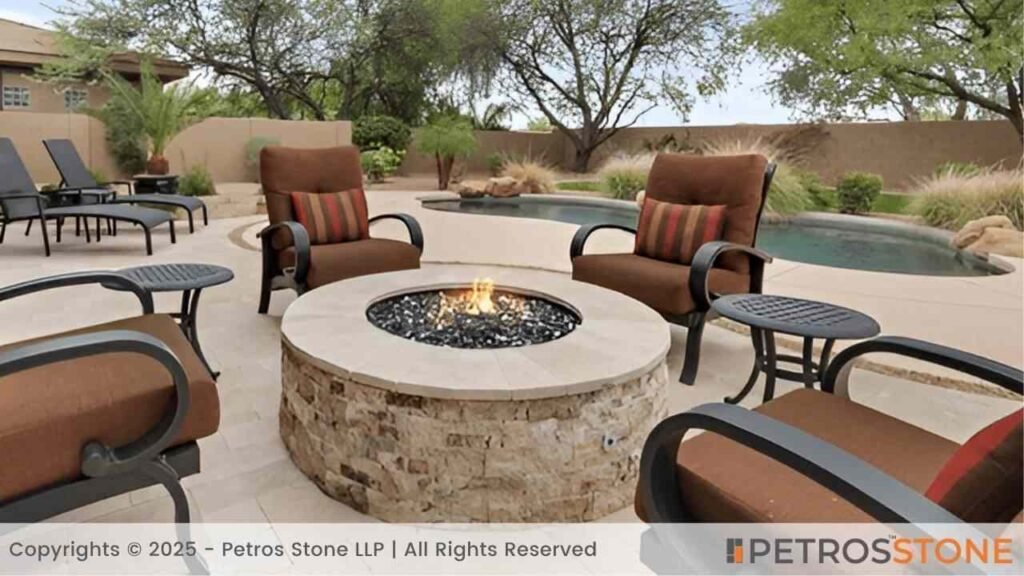
As a strong contender for dry and humid regions, desert multi-stone cladding is the gateway to a sunlit home.
Average Stone Cost: $1.10 – $1.70 /sq ft
Pros:
- With a mix of brown golds and gentle reds, it offers natural warmth and a rustic feel. Because of its stratified layers, the desert stone is a natural insulator for all climates.
- The sandstone composition creates strong resistance to wear, cracking, and breakage. Dirt remains hidden because of its rough, layered surface. And there is no need for frequent attention as colors remain intact for a very long time.
Cons:
- Sandstone can absorb water without proper sealing. It also requires proper anchoring during installation.
- Not so compatible with modern facades.
Top Design Ideas:
- Fireplace Surrounds: Rugged feel for outdoor hearth and chimneys
- Desert Stone Compound Walls: Bold and warm tones for outer walls
- Verandah Backdrop Walls: A bright and lived-in charm for the background
Takeaways:
With their famous earthy texture and long-term performance, an easy choice for exterior design.
6. Indian Autumn Slate Cladding
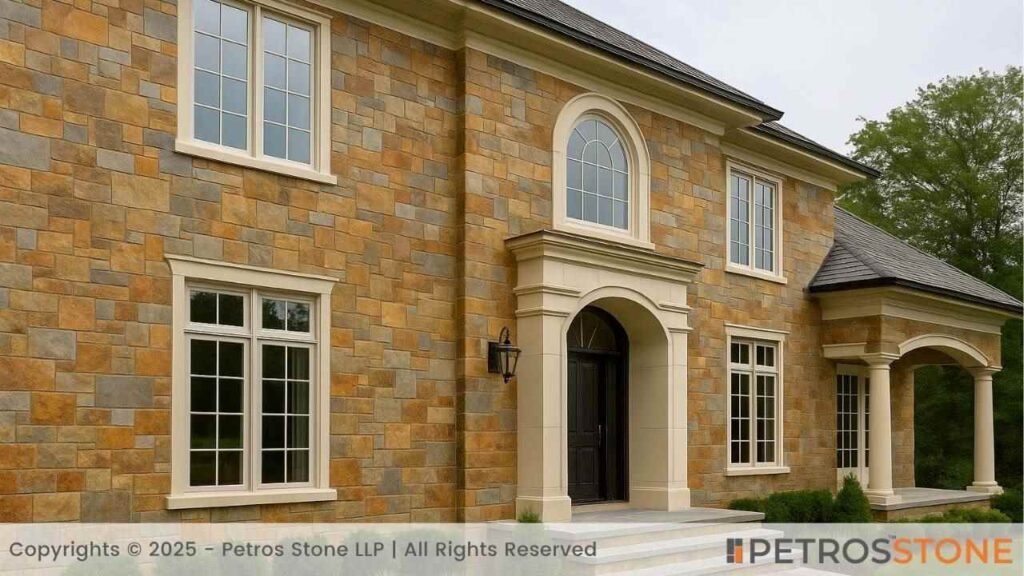
With dynamic colors that shift with light, this option is for homeowners looking for tonal richness.
Average Stone Cost: $1.15 – $1.80 /sq ft
Pros:
- The Autumn slate has multi-faceted colours that are not dependent on paint or polish. Because of surface clefts, it has a great grip suitable for wet regions.
- Its dense structure means very low chances for moisture seepage, making it a good fit for humid or rainy regions. Also, slate is naturally a poor conductor of heat which keeps the interiors cool.
- No need for frequent attention as colors remain intact for a long. It is naturally non-combustible and is an eco-friendly choice for exterior wall stone design.
Cons:
- Hard to place these tiles in uniform patterns, owing to their unique natural designs. And installation requires skilled masonry – its layered structure is prone to chipping if not handled properly.
- It is slightly on the heavier side and calls for proper anchoring. Improper sealing can result in stains or watermarks.
Top Design Ideas
- Feature Wall in Living Rooms: Turning living rooms into statement zones
- Autumn Slate Entry Columns: Warm tones for entries or verandahs
- Outdoor Barbecue Backsplash: Fire-safe grills and stone-lined fire pits
Takeaways:
Indian autumn slate cladding is an easy-to-pick blend of aesthetics and performance.
7. Beige Limestone Split-Face Cladding

This beige limestone is good for modern and traditional exteriors with notable advantages.
Average Stone Cost: $1.20 – $1.95 /sq ft
Pros:
- Its distinct split-faced texture with warm, sandy tones, amplifies curb appeal. And this stone can last for decades with good maintenance.
- Its dense structure dampens sounds, reducing external noise. Also, because of high thermal mass, it regulates indoor temperatures.
Cons:
- If not treated properly in high-impact areas, it is prone to chipping and wear. Without regular sealing, it is sensitive to water absorption in wet or humid areas.
- For a place where leaf litter or spills are common, it is susceptible to stains. And its rough, split-surface can trap dust and grime easily.
Top Design Ideas:
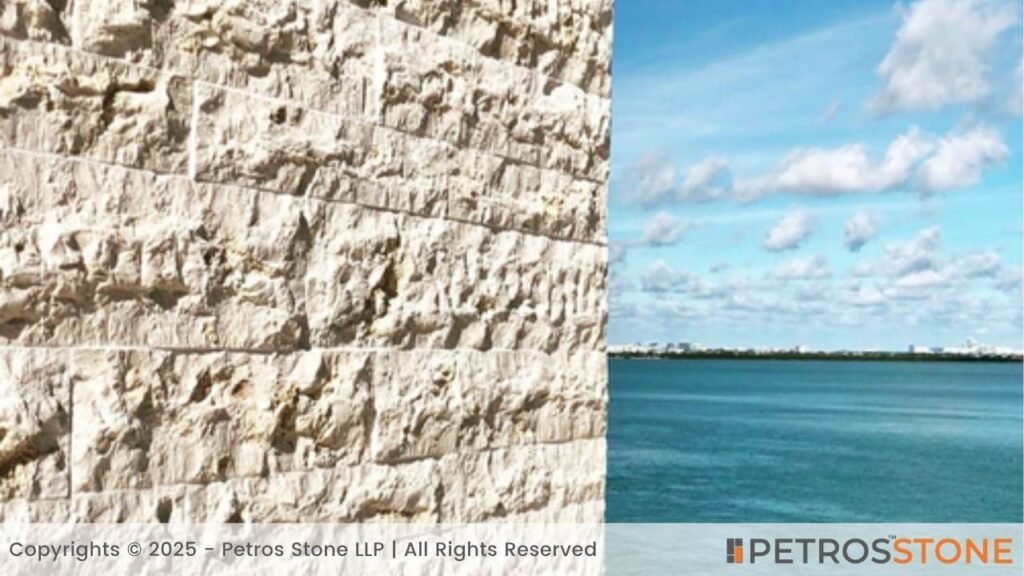
- Courtyard Accent Walls: Catch and play with natural light
- Modern Mediterranean Facades: Warm coastal character for frontage
- Garden Edging Walls: Perfect frames for outdoor greens
- Verandah Niches: Real-depth alcoves and archways
Takeaways:
With the right sealing and installation, beige limestone split-face cladding can be a practical choice for Indian homes.
8. Forest Brown Ledge Quartzite Ledge Panel
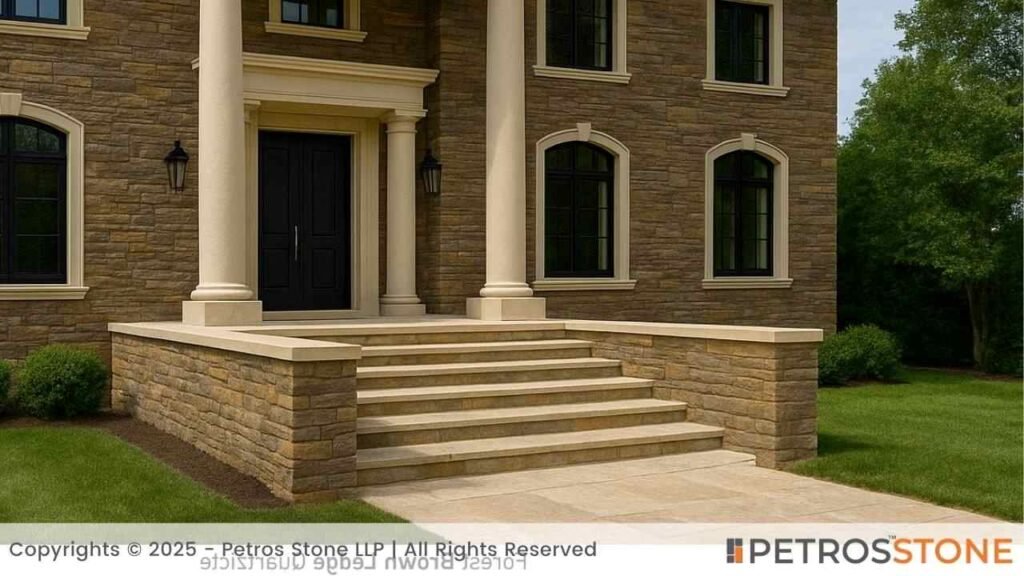
This quartzite ledge panel for the house exterior is known for its strength and endurance.
Average Stone Cost: $1.95 – $3.00 /sq ft
Pros:
- Its striking tones with fine veining add a sophisticated, earthy look to the facades. UV-resistant features ensure it retains color under harsh outdoor light as well.
- While it is highly resistant to scratches, chipping, and wear, its natural ledge texture provides a good grip.
Cons:
- Because of its impressive strength, it demands experienced professionals for cutting and installation. Its heaviness calls for proper anchoring.
- It comes at steep initial prices. Also, with rigid ledge panels, it is hard to fix it in curved or irregular surfaces.
Top Design Ideas:
- Boundary Wall Panels: Deep, rugged finish in earth tones
- Fireplace and Barbecue Walls: Raw character for both indoors and outdoors
- Patio Accent Walls: For green gardens and open terraces
Takeaways:
Despite being a bit too rigid, forest brown ledge quartzite panels are still a superb choice due to their stunning depth, suitable for modern and traditional homes.
9. Tumbled Mint Sandstone Tiles
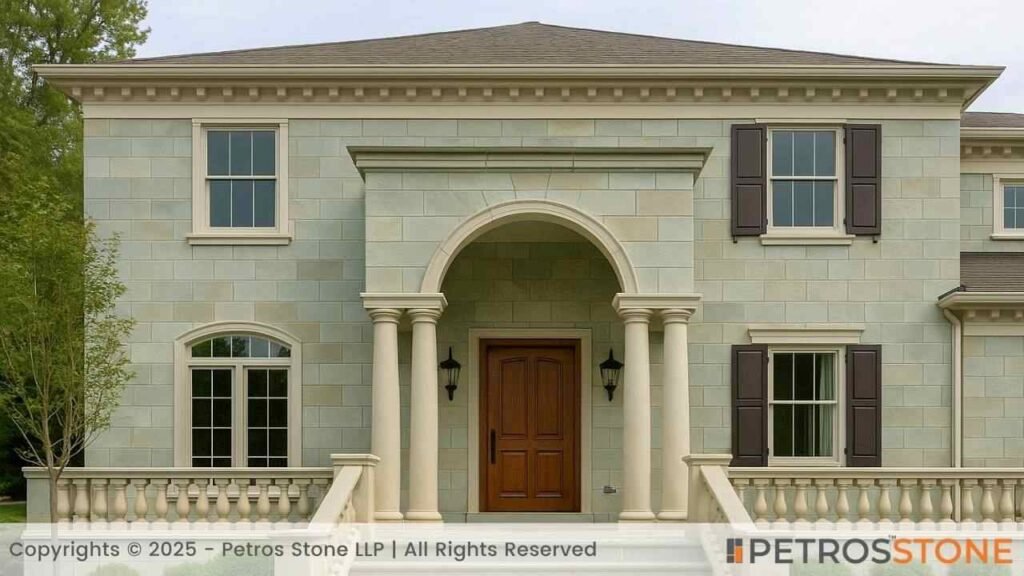
Tumbled Mint Sandstone is a good fit for rustic and elegant looks.
Average Stone Cost: $0.95 – $1.55 /sq ft
Pros:
- Its cool mint-green hue remains fresh even under harsh sun. It is long-lasting, and the tumbled edges give it resistance in slippery situations.
- Its surfaces remain cool, even in peak summer. It is also easy to cut, be it in geometric or natural patterns.
- This sandstone tile ages gracefully like a vine without losing structural integrity.
Cons:
- It calls for regular cleaning to avoid stains or moss, and is not so suitable for those who need consistency in color tones.
- It suits floors better than walls, as vertical use can appear flat.
Top Design Ideas:
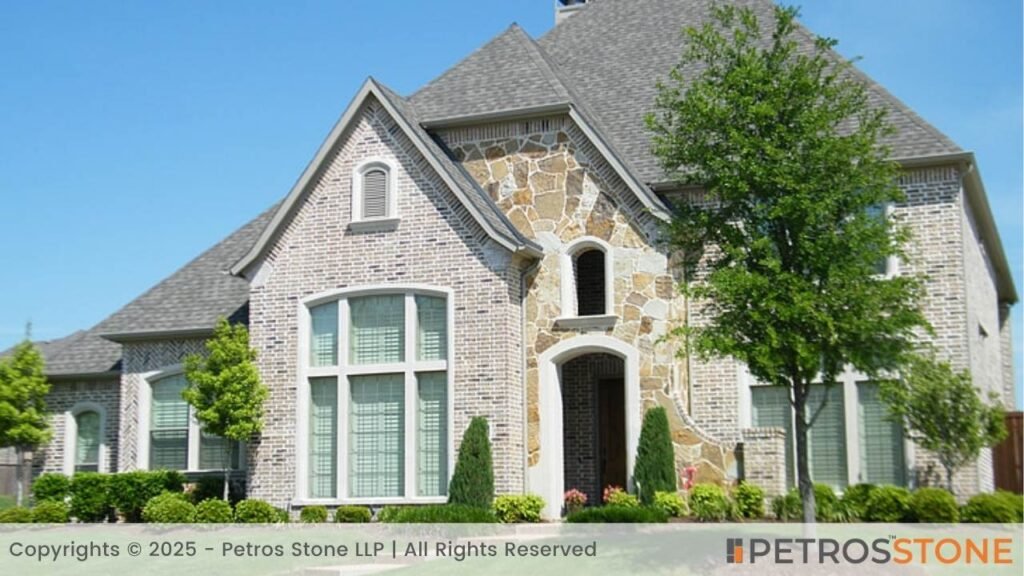
- Courtyard Flooring: Sunlit grounds for traditional homes
- Verandah and Porticos: For relaxed entry zones
- Poolside Decking: Style and grip for pool areas
- Indoor Rustic Flooring: Vintage living rooms and hallways
Takeaways:
Tumbled Mint Stone Tiles are a smart pick for those who want grip, natural coolness, and a time-kissed aesthetic.
10. Golden Yellow Sandstone Strips
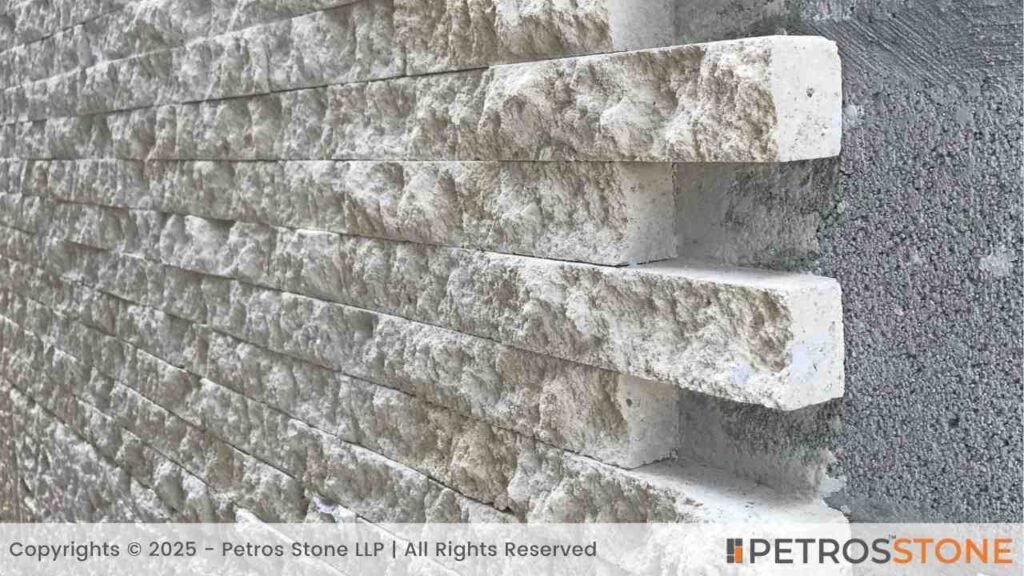
Golden Yellow Sandstone Strips with warm ochre tone are ideal for textured, sunlit walls.
Average Stone Cost: $0.90 – $1.45 /sq ft
Pros:
- It brings a lively, timeless feel, and goes easily with Indian landscapes. It resists weathering, and with proper care, holds up well in exterior conditions.
- Its grainy texture provides a slip-free finish. This stone manages moisture well, but proper sealing is essential to prevent stains.
- Easy to cut and shape, hence versatile with custom wall designs and features.
Cons:
- It is soft and can scratch or chip if roughly handled. Its natural clefts can trap dirt easily, demanding periodic cleaning.
- Colour fading is common due to their natural shades.
Top Design Ideas:
- Strip Accent Wall for Entryways: Sunny depth for foyer and main wall
- Boundary Wall Cladding: Street-side rhythmic tones
- Courtyard Wall Texture: For cheerful open spaces
Takeaways:
Golden yellow sandstone strips are perfect for Indian architectural styles as they offer strength and linearity in compact tile formats.
FAQs
Which stone is best for exterior wall cladding in Indian climates?
Quartzite and sandstone are ideal for Indian weather conditions. They have low porosity, resist thermal expansion, and withstand extreme heat, humidity, and monsoons without cracking or fading.
Is natural stone cladding expensive?
Natural stone ranges from USD 0.80 – 3.60 depending on the type, finish, and sourcing. While the upfront cost may be higher than synthetic options, it offers greater longevity and low maintenance, reducing long-term expenses.
Does stone cladding need regular maintenance?
Most stones require minimal upkeep if properly sealed. Simple cleaning, annual resealing (for porous stones), and occasional washing are sufficient. Avoid acidic cleaners, especially for marble and limestone.
Can natural stone cladding be installed on any wall?
Yes, but it must be installed on a structurally sound surface. Heavy stones like quartzite or marble need proper anchoring and skilled installation to prevent long-term issues like cracking or detachment.
5. What finishes are best suited for exterior applications?
Finishes like split-face, tumbled, or bush-hammered are excellent for exteriors. They offer better grip, weather resistance, and a rustic aesthetic that blends well with outdoor environments.
Is sealing necessary for all exterior stones?
Yes, especially for porous stones like marble, sandstone, and limestone. Sealing helps prevent stains, moisture absorption, and moss buildup—especially in humid or shaded areas.
Summary
This blog brings you the 10 best natural stone cladding options for Indian house exteriors. From Mint Quartzite’s cool elegance to the warmth of Golden Yellow Sandstone, each stone offers distinct visual and functional benefits tailored to Indian terrains and styles. Get the insights you need to help make informed stone choices here.
Key Takeaways
- The right cladding is about meeting design with function.
- Choose stones like quartzites or sandstones to handle Indian weather with ease.
- Organic textures can be timeless and durable if chosen right.
- Surface finishes like split-face or tumbled stones offer good grip, ideal for outdoor use.
- Stones need sealing and cleaning. Choose stones with maintenance needs that suit your lifestyle and budget.
Feel free to get in touch for a free consultation, quote, and get a detailed understanding from our experts here at Petros®. Visit https://petrosstone.com/ or call +91-8446360361 and WhatsApp

Hi, I’m Hemanth, a storyteller at heart with a background in journalism, screenwriting, and brand writing. At Petros Stone, I explore the stories behind materials and transform technical details into content that’s clear, creative, and easy to act on.
Brown Granite
White Galaxy Granite
Blue Bahia Granite
Silver Cloud Granite
Black Pearl Granite
Dallas White Granite



